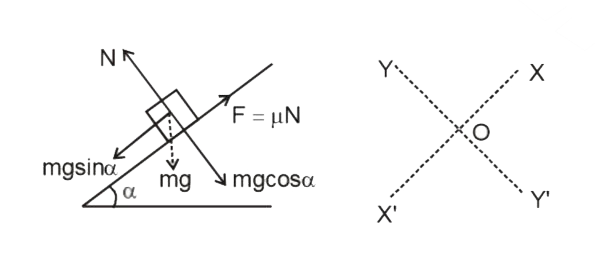A block is at rest at the top of a rough inclined plane of inclination 30° with the horizontal. What is the coefficient of kinetic friction between the block and the plane, if the . block slides down with an acceleration of g5 ?
0.25
0.275
0.325
0.346
The correct Answer is:D
To solve the problem, we will analyze the forces acting on the block on the inclined plane and apply Newton's second law.
1. Identify the Forces Acting on the Block:
- The weight of the block (W) acts vertically downward and can be expressed as W=mg, where m is the mass of the block and g is the acceleration due to gravity.
- The weight can be resolved into two components:
- Perpendicular to the incline: W⊥=mgcos(30∘)
- Parallel to the incline: W∥=mgsin(30∘)
2. Calculate the Components of Weight:
- Using the values of sine and cosine for 30°:
- sin(30∘)=12
- cos(30∘)=√32
- Thus, we have:
- W∥=mg⋅12=mg2
- W⊥=mg⋅√32
3. Determine the Normal Force (R):
- The normal force R acting on the block is equal to the perpendicular component of the weight:
R=mgcos(30∘)=mg⋅√32
4. Apply Newton's Second Law:
- The net force acting along the incline is given by:
Fnet=W∥−Ffriction=mgsin(30∘)−μkR
- The frictional force can be expressed as Ffriction=μkR.
- According to Newton’s second law, the net force is also equal to mass times acceleration:
Fnet=ma=m⋅g5
5. Set Up the Equation:
- Equating the two expressions for net force:
mgsin(30∘)−μkR=m⋅g5
- Substituting the values:
mg⋅12−μk(mg⋅√32)=m⋅g5
6. Cancel Mass (m) and Gravity (g):
- Dividing through by mg (assuming m≠0 and g≠0):
12−μk⋅√32=15
7. Rearranging the Equation:
- Rearranging gives:
μk⋅√32=12−15
- Finding a common denominator (10):
12=510,15=210⇒510−210=310
- Therefore:
μk⋅√32=310
8. Solving for the Coefficient of Kinetic Friction (μk):
- Multiply both sides by 2√3:
μk=310⋅2√3=610√3=35√3
Final Answer
The coefficient of kinetic friction (μk) between the block and the inclined plane is:
μk=35√3≈0.346
- The weight of the block (W) acts vertically downward and can be expressed as W=mg, where m is the mass of the block and g is the acceleration due to gravity.
- The weight can be resolved into two components:
- Perpendicular to the incline: W⊥=mgcos(30∘)
- Parallel to the incline: W∥=mgsin(30∘)
- Using the values of sine and cosine for 30°:
- sin(30∘)=12
- cos(30∘)=√32
- Thus, we have:
- W∥=mg⋅12=mg2
- W⊥=mg⋅√32
- The normal force R acting on the block is equal to the perpendicular component of the weight:
R=mgcos(30∘)=mg⋅√32
- The net force acting along the incline is given by:
Fnet=W∥−Ffriction=mgsin(30∘)−μkR
- The frictional force can be expressed as Ffriction=μkR.
- According to Newton’s second law, the net force is also equal to mass times acceleration:
Fnet=ma=m⋅g5
- Equating the two expressions for net force:
mgsin(30∘)−μkR=m⋅g5
- Substituting the values:
mg⋅12−μk(mg⋅√32)=m⋅g5
- Dividing through by mg (assuming m≠0 and g≠0):
12−μk⋅√32=15
- Rearranging gives:
μk⋅√32=12−15
- Finding a common denominator (10):
12=510,15=210⇒510−210=310
- Therefore:
μk⋅√32=310
- Multiply both sides by 2√3:
μk=310⋅2√3=610√3=35√3
The coefficient of kinetic friction (μk) between the block and the inclined plane is:
μk=35√3≈0.346
Topper's Solved these Questions
- BOOK - MARVEL PUBLICATIONCHAPTER - FRICTIONAL IN SOLIDS AND LIQUIDS EXERCISE - TEST YOUR GRASP10videos
FRICTIONAL IN SOLIDS AND LIQUIDS
- BOOK - MARVEL PUBLICATIONCHAPTER - FORCE, WORK AND TORQUEEXERCISE - TEST YOUR GRASP10videos
FORCE, WORK AND TORQUE
- BOOK - MARVEL PUBLICATIONCHAPTER - MAGNETIC EFFECT OF ELECTRIC CURRENT EXERCISE - TEST YOUR GRASP10videos
MAGNETIC EFFECT OF ELECTRIC CURRENT
Similar Questions
The coefficient of friction between the block and the inclined plane is μ.
View SolutionA 20kg box is gently placed on a rough inclined plane of inclination 30∘ with horizontal. The coefficient of sliding friction between the box and the plane is 0.5.Find the acceleration of the box down the incline.
 View Solution
View Solution
Knowledge Check
- Question 1 - Select One
A block of mass 2kg rests on a rough inclined plane making an angle of 30∘ with the horizontal. The coefficient of static friction between the block and the plane is 0.7. The frictional force on the block is
A9.8NB0.7×9.8×√3NC9.8×√3ND0.7×9.8N - Question 2 - Select One
A block rests on a rough inclined plane making an angle of 30∘ with the horizontal. The coefficient of static friction between the block and the plane is 0.8. If the frictional force on the block is 10N, the mass of the block (in kg) is
A(a) 1.6B(b) 4.0C(c) 2.0D(d) 2.5 - Question 3 - Select One
A block is stationary on an inclined plane If the coefficient of friction between the block and the plane is μ then
 .Aμ>tanθBf=mgsinθCf=μmgcosθDthe reaction of the ground on the block is mg cos θ
.Aμ>tanθBf=mgsinθCf=μmgcosθDthe reaction of the ground on the block is mg cos θ
A block of mass m moves with constant speed down the inclined plane of inclination θ. Find the coefficient of kinetic friction.
 View Solution
View SolutionA block rests on a rough inclined plane making an angle of 30° with the horizontal. The coefficient of static friction between the block and inclined plane is 0.8. If the frictional force on the block is 10 N, the mass of the block is
View SolutionA block of mass m is placed on a rough inclined plane of inclination θ kept on the floor of the lift. The coefficient of friction between the block and the inclined plane is μ. With what acceleration will the block slide down the inclined plane when the lift falls freely ?
View SolutionA block of mass m slides down an inclined plane which makes an angle θ with the horizontal. The coefficient of friction between the block and the plane is μ. The force exerted by the block on the plane is
View SolutionA block of mass m is placed at rest on an inclination θ to the horizontal.If the coefficient of friction between the block and the plane is μ, then the total force the inclined plane exerts on the block is
View Solution

